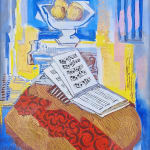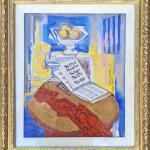


Ismael González de la Serna Spanish, 1898-1968
Framed size: 50 cm x 44
Signed
Bibliography
Cesáreo Rodrigues-Aguilera, De La Serna
Editions Cercle d'Art, Paris 1977. Illustrated No. 76
Literature
Ismael González De la Serna was born in 1898 in Granada, Spain. He began painting and drawing when he was nine years old. While in school, he became friends with Federico Garcia Lorca, later to become a famous poet. Indeed, it was de la Serna who in 1918 illustrated the cover of Garcia Lorca's first book, Impresiones y Paisajes.
De la Serna pursued his studies at the Academy of Fine Arts in Granada, where he learned the traditional rules of composition, form, and colour. A turning point came in his life in 1917, when he viewed an exhibition of French Impressionists in Madrid, whilst furthering his studies at the San Fernando Royal School of Art, also in Madrid. By his own testimony, thereafter he was determined to be a “free” painter, devoted to new forms.
Determined to follow his own vision, de la Serna moved to Paris in 1921. Initially he lived an impecunious and bohemian life in Montparnasse where he met fellow Spanish artists, also lured by the less rigid and academic view that Spanish galleries and critics adopted at that time. He was introduced to Picasso by the writer, critic, and art collector known as Tériade. According to Tériade, Picasso, upon seeing de la Serna's work, exclaimed: “At last, a true painter! As grand as Juan Gris!”
The year 1927 was one of remarkable success for de la Serna. Tériade devoted an article on him in an issue of the art review, Cahiers d'Art, which simultaneously covered the works of luminaries such as Renoir and Picasso. Tériade wrote that de la Serna was the painter “we had all been waiting for.” That is, his poetic sensibility lent a certain unity to his work and deftly combined a vigour of expression with a delicacy of form.
Galerie Paul Guillaume organized an exhibition of fifty of de la Serna's works to wide acclaim also in 1927. An individual exhibition at the Gallery Flechtheim in Berlin was equally successful, all of the works found buyers. The gallery even signed de la Serna to a contract, which remained in effect until 1933, when Hitler's rise to power forced its revocation.
Ismael de la Serna had been warmly received throughout Europe. In 1928, he signed contracts to exhibit his works at the Galerie Zak in Paris in 1930 and at the Galerie Le Centaure in Brussels. The art critic and founder of the influential publication ‘Cahiers d’Art’ Christian Zervos, wrote enthusiastically in the magazine that de la Serna's incredible skill at drawing allowed him to make abstractions of reality.
He continued to paint in a Post Cubist style, although during the Second World War his paintings became more influenced by Expressionism and Abstraction. During the '50's and '60's his painting became more naturalistic, evolving into compositions of pure colour and form. Christian Zervos, thought that "the artist easily balanced and reconciled the extremes of both representation and abstraction".
In 1930, The National Gallery of Berlin, and the Museum of Mannheim both acquired several of his paintings. In 1932, he returned triumphantly to Spain, where he toured with successful exhibitions throughout his homeland. In 1936, he took part in an exhibition at the Musée du Jeu de Paume in Paris, and in 1937 exhibited at the Paris International Exposition in the Spanish Pavilion, where Picasso also exhibited 'Guernica' for the first time.
After the Second World War, his paintings continued to be shown in France, Germany, Spain, and Mexico. In 1963, he was invited to participate in an exhibition of French paintings at the Tate Gallery in London and in an exhibition at the Hammer Gallery in New York.
Ismael de la Serna died in Paris in 1968. In 1974, the Musée d'Art Moderne de la Ville de Paris organized a retrospective of nearly one hundred of de la Serna's paintings from throughout his career. The retrospective tracked the artist's diversity of subjects and the technical scope of his talent.
The Musée de l'Art Moderne in Paris, Reina Sofia Centre in Madrid, the National Gallery of Madrid, and the National Gallery of Modern Art in Mexico all hold examples of his work.
Publications
Cesáreo Rodrigues-Aguilera, De La Serna
Editions Cercle d'Art, Paris 1977. Illustrated No. 76
Join our mailing list
* denotes required fields
We will process the personal data you have supplied in accordance with our privacy policy (available on request). You can unsubscribe or change your preferences at any time by clicking the link in our emails.

